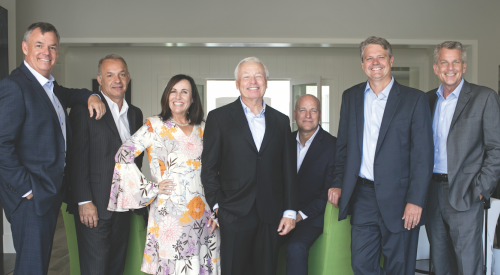Put yourself in Larry Webb's shoes. You're the CEO of the country's second largest private home builder, based in Newport Beach, Calif., at the heart of the Southern California home building market, and you just sold your business at the peak of the market. The housing industry takes what can politely be described as a nose dive, and you have to not only manage the company through those turbulent times but also explain to the new Dubai-based owners why the company is not performing as well as it did when they bought it. They have to wonder, was John Laing Homes a house of cards?
How Do You Get Your Company Through That?
Leadership, innovation, proven performance, and community involvement. Those are the attributes the editors of Housing Giants looked for when we decided to name our first-ever CEO of the Year. Webb excelled in all those characteristics under circumstances that had a kind of brunt brutality about them — a forcefulness of hard choices.
In evaluating the last year, Webb turns to Charles Dickens for the right turn of phrase. "Charles Dickens wrote A Tale of Two Cities," he says. "He was writing about the French Revolution, and the first two sentences are, 'It was the best of times. It was the worst of times.'" Webb looks over the last year and takes pride in what the sale of the company did for the people in the firm. "It was an incredibly good thing for our employees and 41 of our employee owners," he says.
At the same time, the down market caused real turmoil for all home builders, and John Laing Homes didn't escape. 2006 closings were 21 percent below the previous year, and revenue dropped 3 percent. Webb adds, "We had reductions in force and went through a whole series of difficult management exercises that made it a difficult year as well."
Past Is Future
The most revealing thing about Larry Webb is that he spent 10 years teaching high school history and coaching soccer. That past is a window into his present. We often look to teachers and coaches as good examples of leaders, but more often than not we find practitioners in those arenas who exemplify all that is bad about leadership: the screaming, the sarcasm, the favoritism. But Webb has taken the attributes of a great teacher or coach and used them to unending advantage in the business environment. In fact, in many ways, his success at navigating the last year at John Laing Homes is a result of his comfort with being a teacher and coach.
Recently, Webb kicked off a mentoring session part of the company's Leadership Advantage Program. Through the LAP, John Laing Homes identifies employees with leadership potential and runs them through a one-year program that requires a significant time and effort commitment. Each employee is involved in four one-week sessions throughout the year and required to accomplish other work in between. At the end of the program, John Laing Homes has a new batch of well-trained, company-inspired leaders.
The program has been working for seven years and one aspect of it is that senior Laing executives mentor participants. Watching Webb stand in front of that room, calmly speaking without notes but clearly making distinct points, you can see the teacher and coach. You also see from the quick gibes and friendly trash talking that John Laing Homes is a very competitive environment. It is a culture so easily defined that an outsider can put his finger on the crux of the culture after just moments of exposure.
Why is that important? Because after the sale of John Laing Homes to Emaar Properties, Webb's job became, in part, to maintain the culture of an environment that had delivered significant success over the years. "I have twofold challenges," he says. "One is to develop a relationship with the new owners so they can trust me that what I'm doing is in the best interest of our new ownership. And then, while at the same time, not changing the values in place that I have."
Those values, while driven by Webb, are exemplified and brought to life by employees. "I know that this home building thing is the ultimate team-building deal," he says. Later, he adds, "I have an overriding belief that it's all about the people."
So what are those people like? Webb says they possess these characteristics:
- Self-aware
- Passionate about business
- Competitive
- Have a good balance in their lives
- Care about their staff
- Always try to learn or get better
Joan Marcus-Colvin is vice president of sales, marketing and design for the Luxury Division. She provides this insight about Webb and his ability to create a specific culture: "He's very direct and very fun. He wants us to do our best work. If something doesn't work, he says, 'Try something new.' This is the third down cycle I've been through, and there is no place I'd rather be than here." Marcus-Colvin has thrived in the company culture because it fits her.
That culture is the foundation for the success of John Laing Homes, and Webb — teacher and coach — has a very specific role creating and maintaining the culture. "I get up and I love being in charge. I like being the leader. I really do," he says.
"My job as leader ... is to make sure the right people are in place and to lay that philosophic foundation — then get out of the way."
Managing the Down Market
While everything around John Laing Homes has changed — from the market to the ownership driving it strategically — the most important elements have not altered a bit. "The core values I lead the company by," says Webb, "have not fluctuated or changed. Laing has this very serious commitment to our employees and our customers. And those are the pillars by which I try to manage."
This market though can test those pillars. As Wayne Stelmar, CFO for John Laing Homes says, "Virtually every market slowed dramatically. From a people perspective, on part of the 1,000-plus employees working for us at the close of the transaction with Emaar, a number had expected much more explosive growth and a number were unhappy we were not moving forward at the pace originally anticipated."
Reductions in force since the sale have brought the employee total down to approximately 800. Last year, only about half the employees earned bonuses, and no one received pay raises, Webb says. In that environment, new threats to the culture pop up. People go into their own silos and stop communicating with other departments; departments tend to point fingers at other departments and toss blame; office staff find more reasons to stay in the office and not go into the field.
Those threats developed and required direct action from leadership. Webb responded in three ways:
1. He visited every division and spoke to all the employees about what was going in the company, both good and bad. The division president then told everyone what was going on in the division.
2. He communicated a plan of action to change what was not working.
3. He follows up and monitors the action plan.
One of the most significant parts of the communication is a monthly teleconference with every employee of John Laing Homes. Called "Fridays with Larry," Webb spends 15 to 20 minutes addressing what has worked and what hasn't worked for the company over the last month. Employees can e-mail questions for Webb to answer.
Marcus-Colvin captures the necessity of clearly communicating during a down market. "We had a field guy ask a very simple question about whether or not he was going to receive his bonus." Without flinching or shying away from the question, Webb explained that he would not. People, Marcus-Colvin says, understood the reason and appreciated both the directness and honesty of the answer. "I don't know many people who could give bad news from the heart the way Larry did," she says.
The results show in the employee satisfaction surveys. Nine out of 10 employees take the survey, which is a high response rate. "An extremely high percentage of people believe in the vision and values of the company," Webb says. "They express that over and over in the survey ... on the negative side, the market uncertainty, understanding if they have a future with the company, and still trying to understand what the new owners will be like. All of those things are issues that ... I have to deal with."
The New Business Owners
All of that — dealing with employees, managing during a down market, communicating, and establishing the culture — are things Webb has done many times in the past. Those tasks are to some extent commonplace.
But who in the U.S. home building market has had to work with new owners as removed as Emaar Properties? Before accepting the Emaar offer, Webb established a condition. He wanted to go to Dubai and meet Mohammed Ali Alabbar, the 47-year-old chairman of the publicly traded company. At the most elemental, Webb wanted to get comfortable with the purchasers. He admits the need to make this very critical decision was difficult. "It's compounded by the different cultures, different religions, a 12-hour time difference ... the American/Middle East thing," he says.
Ultimately, Webb felt comfortable signing the contract, and he now speaks with admiration of the company and his new venture. "One of the overriding things I've found is that the Emaar group is made up of people from all over the world, but the one thing they have in common is they're really smart. They get this business."
Why, though, would Webb lead his company through this sale? The industry was strong, growth was good, the company performing well. By all measures, John Laing Homes probably could have continued to operate smoothly and efficiently.
To some extent their hands were forced. According to Stelmar, John Laing Homes was in an awkward position because GMC was selling off its financial firm GMAC, which held a 56 percent ownership stake. New owners were inevitable. And, of course, several public companies had expressed interest.
There was an indication from past history that Webb and his team would be uncomfortable with their fate in someone else's hands. In 2000, the board of directors of WL Homes, which had been formed from the merge of Watt Residential Partners and John Laing Homes, decided to sell the company and began shopping it to public builders. Webb and Stelmar, CEO and CFO, put together an ownership bid that allowed the company to remain private and control to stay local. The sale to Emaar Properties allowed the management team to retain the same control.
A year into his five-year contract, though, you would not wonder if Webb might have doubts. "If Emaar didn't buy us, my life ... would have been a lot easier because we had 10 years of being successful together. We would probably have not grown at all. We would probably have shrunk the company. We would have circled our wagons, but we would have ridden out a down market with no problem."
That, of course, is not the present path. Emaar wants expansion and financial returns, and the pressure can be significant. About the tone of a recent board of directors meeting, Webb said, "They can be very direct."
How does Webb manage his new owners and his company during a down market? It should be no surprise for a person who is still at heart a teacher and coach. "I'm really trying to do it in the same way if we hadn't been purchased," he says.
June 1, 2006: Date John Laing Homes sold to Emaar Properties
$1.05 Billion: Sale Price
$580 million: Amount received by GMAC, which owned 56 percent of Laing
$315 million: Amount received by the Ray Watt family, which owned 30 percent
$147 million: Total amount received by 41 employee owners
5 years: Duration of employment contracts for CEO Larry Webb, CFO Wayne Stelmar and other top executives
2,891: 2005 Closings
2,269: 2006 Closings
-21.5%: Change in closings 2005 to 2006
$1.63 billion: 2005 Revenue
$1.58 billion: 2006 Revenue
-3%: Change in revenue 2005 to 2006
Book List
As part of the Leadership Advantage Program, John Laing Homes provides a recommended reading list for company leaders. The 33 books range from subjects such as process mapping to the history of the Battle of Gettysburg. "I'm not a guy who likes business books too much," says CEO Larry Webb, "because too many of them sound like "The Five P's of Leadership."
He does have favorites, though, and is a believer in the Jim Collins books Built to Last: Successful Habits of Visionary Companies and Good to Great: Why Some Companies Make the Leap ... and Others Don't.
Other books on the list:
- First, Break All the Rules: What the World's Greatest Managers Do Differently, by Marcus Buckingham and Curt Coffman
- Primal Leadership: Realizing the Power of Emotional Intelligence, by Daniel Goleman, Annie McKee and Richard E. Boyatzis
- Getting Things Done, by David Allen
- The World is Flat, by Thomas L. Friedman
- Decision Traps: The Ten Barriers to Brilliant Decision-Making and How to Overcome Them, by J. Edward Russo and Paul J. H. Schoemaker
- Shackleton's Way: Leadership Lessons from the Great Antarctic Explorer, by Margot Morrel and Stephanie Capparell
- The Killer Angels, by Michael Shaara












